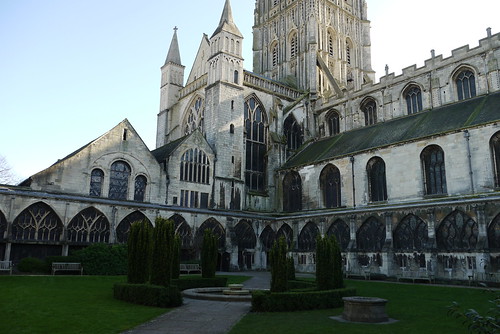Gloucester Cathedral has been a place of Christian worship continuously for over 1,300 years, since Osric, an Anglo-Saxon prince, founded a religious house here in 678-9 AD. Little is known for certain about the communities which worshipped here or the buildings they used over the next 400 years although it is believed that the Benedictine Rule was introduced here early in the 11th century.
A record of the building fabric is made before and during stonework conservation, detailing the information that repair works uncover about building history and early building techniques. For a selection of archaeological reports concerning this, see www.bgas.org.uk/gcar.
At the time of the Norman Conquest in 1066, the monastery was not thriving and in 1072 King William I appointed Serlo, a monk from Mont St Michel in Normandy to be its Abbot. An energetic, charismatic and devout man, Serlo built up the wealth of the monastery to the point where in 1089 he was able to start building the magnificent abbey church which so impresses the visitor today.
A wealthy and powerful institution with extensive landholdings in Gloucestershire and South Wales, the Abbey of St Peter (as it was known) had significant royal associations.
In 1216, Henry III, who had succeeded to the throne at the age of only nine, was crowned here. Major building works in the 13th century included a first Lady Chapel and new Tower and refectory.
Most importantly for the subsequent history of this place, in 1327, King Edward II who had died in Berkeley Castle (in suspicious and, traditionally, gruesome circumstances) was buried here. A shrine-like monument was erected over the tomb of the dead king. Royal patronage and popular devotion led to funds flowing into the abbey, and these enabled the magnificent remodelling of the east end to be carried out in the very latest “Perpendicular” style.
In the 15th century further building work included the remodelling of the west end, the building of the south porch and of the present tower and finally, towards the end of the century, the present Lady Chapel.
Henry VIII ordered the monasteries to be dissolved and Gloucester Abbey surrendered in January 1540. The abbey buildings became Gloucester Cathedral, the seat of the Bishop of Gloucester in 1541. No longer a community of monks, it was to be led by a Dean and a chapter of canons.
The ideological and doctrinal struggles of the 16th and 17th centuries made their mark in Gloucester: Bishop Hooper was burned at the stake here in 1555 on the orders of the Catholic Queen Mary; in the 1620’s Bishop Miles Smith and his Dean, William Laud held profoundly different views on what the nature and style of Church of England should be.
Then under Oliver Cromwell there was a move to demolish the cathedral building altogether (it was saved by the intervention of the mayor and burgesses of the City of Gloucester).
With the restoration of the monarchy (after the civil wars and Commonwealth period) in 1660, the Dean and Chapter resumed the running of the Cathedral and that is how it is managed today.
Throughout the 18th, 19th and 20th centuries they have carried out repairs and conservation work rather than rebuilding or remodelling the building.
More importantly, Gloucester Cathedral has endured through the centuries as a place of Christian witness where God is worshipped and the gospel of Jesus Christ is proclaimed every day.
2 Comments CherryPie on Feb 26th 2016










Many years ago in a previous life, I worked for BT and my manager at the time had his office for Gloucester and I used to go there about once a month. I sometimes had time to look round the city centre and occasionally opted into the cathedral. I’ve not been there now for 17 years so it’s time I went back. I liked your soldiers in the poppy field shot.
It is well worth a visit, we intend to go back again in the not too distant future